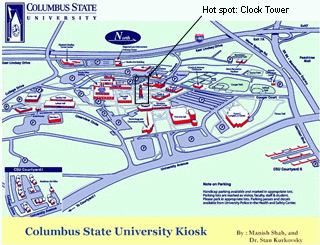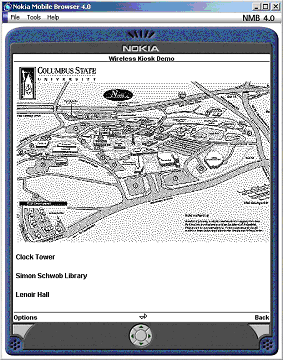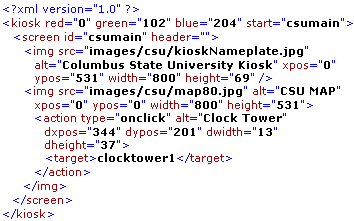Kiosk Engine
Kiosk Engine (KE) is a portable application for managing content and displaying multimedia kiosk applications. An early version of Kiosk Engine won the 2nd place at the 2003 ACM student project competition in Gatlinburg, TN. Kiosk Engine is written in Java and designed to be portable and lightweight. Kiosk Engine supports WML, which makes interactive kiosk content available to all WML-enabled devices, such as mobile phones with Internet connectivity.

 Guidelines for design and implementation of Kiosk Engine were as follows:
Guidelines for design and implementation of Kiosk Engine were as follows:
- It should be easy to create, access (from either web or stand alone), modify and store the kiosk. Consequently, upgrades and changes to a kiosk should be easy.
- KE should be light weight and be able to run on majority of the existing software and hardware platforms.
- KE-driven kiosks should support five basic types of multimedia data: text, images, documents (containing plain/rich text or HTML), audio and video.
- Isolate the data (i.e. text, images, audio, video, etc.) of a kiosk from the processing program.
- The same version of KE should be able to act as a driver for multiple kiosks.
 The features of kiosks
that make it especially appealing to
mobile devices are user interactivity, ease of use and access, and high quality
of communication. A kiosk implemented as a lightweight client should be easily
adaptable to run on a device with limited processing power to present
information in a visually appealing manner to mobile users. The interactive
capabilities mean that people on the go do not merely access the content pushed
to them, but can also interact and respond with real-time feedback to the
provider of the content.
The features of kiosks
that make it especially appealing to
mobile devices are user interactivity, ease of use and access, and high quality
of communication. A kiosk implemented as a lightweight client should be easily
adaptable to run on a device with limited processing power to present
information in a visually appealing manner to mobile users. The interactive
capabilities mean that people on the go do not merely access the content pushed
to them, but can also interact and respond with real-time feedback to the
provider of the content.
Kiosks on wireless devices can display multimedia data such as images and thus provide high quality communication. Information is presented in a graphical fashion and in an easy-to-use format. Businesses can minimize manual intervention by providing updated content to users on their wireless devices. For example, in a museum, the number of human tour guides can be minimized by providing the information as a kiosk application on the users' mobile devices.
KE can work as a driver of a kiosk when provided with the input consisting of multimedia data, their description and the overall organization on the kiosk. KE accepts the input written in a specially developed XML-based language called XMLKiosk, which describes the sources, organization, presentation order, size and style of multimedia elements.
 KE
places most of the processing on the server, which makes it easily extensible to
wireless devices. We used a Wireless Application Protocol (WAP) gateway to
convert XML tags to Wireless Markup Language (WML) tags. This gateway or proxy
server also converted all image files into WBMP format and performed other
conversions in order to be adaptable to a smaller screen size and constrained
processing power and storage available on mobile devices. WML provided the front
end and user interface for the kiosk application that employed Java Server Pages
(JSP) as the underlying enabling technology (we used Tomcat server). WML tags
were dynamically generated based on user input. Since the kiosk is an
interactive application, user interface is simple and easy to use.
KE
places most of the processing on the server, which makes it easily extensible to
wireless devices. We used a Wireless Application Protocol (WAP) gateway to
convert XML tags to Wireless Markup Language (WML) tags. This gateway or proxy
server also converted all image files into WBMP format and performed other
conversions in order to be adaptable to a smaller screen size and constrained
processing power and storage available on mobile devices. WML provided the front
end and user interface for the kiosk application that employed Java Server Pages
(JSP) as the underlying enabling technology (we used Tomcat server). WML tags
were dynamically generated based on user input. Since the kiosk is an
interactive application, user interface is simple and easy to use.
Students
- Manish Shah
Publications
- Available here